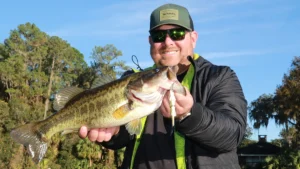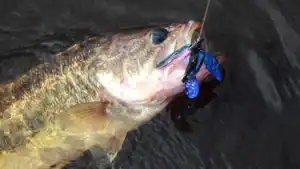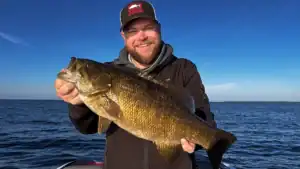Contrary to popular belief, topwater fishing is not simply limited to lowlight conditions. In fact, some of the most vicious blowups you’ll ever see occur in the middle of sunny, bluebird-sky days. Last weekend, I got the chance to experience this phenomenon first-hand, and you couldn’t slap the grin off my face all day. If you know what conditions to look for and the correct presentation for each condition, you can get your fill of topwater excitement all day long.
Weather conditions for topwaters
It is important to understand that just because you get a wild hair to throw a topwater plug all day, doesn’t mean they’re going to eat it. Certain conditions often enable anglers to capitalize on this special bite.
The single, most helpful environmental variable when looking for an all-day topwater bite is wind. When the water is dead-calm, bass are extremely skittish and will spook at the smallest inclination of something unnatural – a loud splash or noisy rattles – anything that doesn’t seem “right” to them. Frankly, they can be a pain in the rear end in calm water. For that reason, a slight breeze is ideal when fishing topwater because the bass don’t get a perfect look at the bait, therefore making them more apt to attack it. The wind slightly breaks up the profile of the lure, resulting in the fish having a difficult time spotting anything out of the ordinary.
There is a fine line, however, between “just enough” and “too much” wind. An excessive amount of wind can make your lure very difficult for the bass to track, considerably diminishing your chances of getting bit. In extra-windy conditions, subsurface baits such as jerkbaits and spinnerbaits on windblown banks prove to be more operative.
Anglers often overlook the effect of barometric pressure when targeting big topwater bass. Have you ever noticed how tough the fishing becomes right after a weather front has pushed through your area? When a weather system moves through, an area of high barometric pressure is usually left behind. The high pressure causes the forage to become less-active, and in turn, the bass can seemingly shut off like a light switch. When this happens, bass often position tightly to cover and often don’t roam much, making them tough to catch with reaction baits. In these situations, a solid topwater bite can be very hard to find.
Conversely, before a weather front reaches your area, it is generally led by an area of low barometric pressure. Bass absolutely love low pressure and feed aggressively throughout the day, making topwater fishing a tremendously effective technique. As the lower pressure moves through an area, it will push the pods of shad upwards towards the top of the water column. This is when you will begin to notice a great deal of surface activity, such as shad skipping across the surface and bass blowing through the bait clouds. Walking topwater baits or small prop baits are ideal on low-pressure days, as they are outstanding imitations of frantic, fleeing shad.
In regards to cloudy versus sunny skies, there are two different trains of thought on topwater fishing. On overcast days, bass will not position as tightly to structure, therefore roaming around and searching for food much more. This will make the bass much more accessible, as they will emerge from thick cover, but they will be spread out and pinpointing them proves more difficult. In sunny conditions, however, the bass may not be feeding as aggressively, but when they blow up on your bait, they will absolutely choke it. During sunny conditions, it is necessary to make long, accurate casts to specific cover such as stumps and blowdowns. There is no science behind topwater fishing in cloudy versus sunny skies, so I always like to try it regardless of the skies—sometimes keeping the bass honest is the most effective way to get on a great pattern.
Water conditions
Topwater fishing is heavily dependent upon the bass’ ability to see the bait. In order to maximize your chances of success, it is imperative to find the clearest water you can possibly find, which is usually located in the lower end or dam-area of most lakes or around natural vegetation that often filters out the silt in the water. Clear water allows the bass to locate the bait from a longer distance and get a much better “bead” on the bait.
In clear water situations, very careful attention to detail on your baits is vital. I like to replace my back treble hook with a feathered treble hook—when the bait is paused, those small feathers barely move, but it’s often enough to entice a strike from a following bass. When I throw walking baits in areas where threadfin shad is the primary forage, I draw the characteristic dot behind the gill plate with a permanent marker. If I’m in a clear water fishery that’s home to a lot of blueback herring, I will only use topwaters with a blue hue to them. There are countless adjustments you can make—sure, they’re very small adjustments, but seemingly trivial modifications make an enormous difference in clear water fisheries.
While topwater baits can certainly draw strikes in stained water throughout the day, you will notice an increase in slaps and short-strikes due to the lack of visibility, as it will inhibit the bass’ ability to accurately target your offering. To combat this, I use very bright, loud baits in dirtier water. It may look a little unnatural to the human eye, but a chartreuse belly is much easier for a bass to hone in on than a bone-colored belly. Stained water will also require repetitive casts to the same piece of cover. You may have to throw 20 times at the same stump to get that 5-pounder to bite.
Conditional presentation
The right weather and water conditions are great when fishing topwater, but neither will do you a bit of good without the proper presentation. There are hundreds of different ways to fish topwater baits, but a select few tactics are most helpful when searching for that special, all-day topwater bite.
Clear water requires extremely long casts, so loosen that tension on your reel and start firing away. I’m not talking about 20-yard casts – more like bombing 40-yarders. While it may seem like overkill, it will dramatically increase the number of bites you get. I also tend to work my bait much faster in clear water. As discussed earlier, I don’t want the fish to get a great look at it. Instead, I am trying to solicit a reaction bite, and fishing a bait quickly will accomplish that goal. If you tick ‘em off enough, almost any bass is catchable.
When I encounter dirty water and/or cloudy skies, I am thinking one thing—I want to make a racket. I want every fish in the area to see and hear my bait coming through the water. Even if they’re not hungry, you need to have the mindset that you’re going to make them eat. Because I tend to get a lot more strikes on-the-pause in these conditions, I like to frequently pause my bait for extended amounts of time—usually until the rings from its surface disturbance fade. While it does take patience to fish in this manner, you’ll get plenty of confidence in it after the first few bites.
Topwater fishing throughout the day doesn’t work every single time—several variables need to fall into place. However, it’s certainly an undervalued tactic within the bass fishing world. Big bass see jigs, worms and crankbaits all the time—when was the last time they saw a big, ugly topwater plug knocking around above their heads? If you think outside the box at times, you will surprise yourself. Remember, it doesn’t always have to make sense. If you find them crushing a topwater in the middle of a sunny day, don’t question it; just smile and enjoy it!















